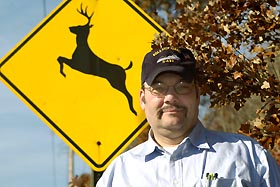|
This is an archived article.
For the latest news, go to the Advance
Homepage
For more archives, go to the Advance Archive/Search Page. |
||
|
Deer-Whistles Ineffective,
Says Bioacoustics Researcher By Janice Palmer Slow down! Deer crossing. It's a warning to be heeded this time of year. Deer are on the move during late fall and early winter, either because it's hunting season or because they are seeking a mate. On the highways and byways across North America, nearly 750,000 collisions occur each year between deer and vehicles. Efforts to reduce that number have spun off a multi-million-dollar industry: deer whistles.
Scheifele, an animal bioacoustics and audiology expert, wanted to know more about the devices, so he and his research team scientifically tested their effectiveness. The small plastic whistles, easily attached to car bumpers, hit the marketplace several years ago. Some are sold for as little as five dollars. They vary in design, but their claims are relatively the same. Their manufacturers promote them as "acoustic attention-getters", alleging deer would react to the whistle by remaining still. "There has been a lot of conjecture about whether the whistles work or don't work, and we are one of the first independent groups to scientifically test them," says Scheifele, director of bioacoustic research at the National Undersea Research Center at Avery Point and a researcher in the Department of Animal Science. He and his team tested six air-fed whistles in the laboratory and in the field. The study's goal was to determine the actual frequencies generated by the whistles and the intensity at which they are produced, compare that data to the hearing abilities of deer, and then take the animal's acoustic behavior into consideration. Following the directions on each package, the team mounted the devices onto a car's front bumper. Using a road closed to the public, they drove the car at speeds ranging from 30 to 45 miles per hour while recording sound and data. "We tested them strictly from an acoustical point of view," explains Scheifele. He found that the whistles typically produce a signal either at a frequency of 3 kilohertz (kHz) or 12 kHz. Both, as it turns out, are problematic. The hearing range of white-tailed deer, the most common species in the United States, is between 2 kHz and 6 kHz, so the animal is not capable of hearing the 12 kHz signal. Although deer may be able to hear the 3 kHz signal, it is only 3 decibels louder than the road noise created by the car, so the signal is buried. Scheifele points out that the situation would be worse with additional traffic in the area or if the wind was blowing. Since completing the study, a new electronic whistle has been put on the market. Although Scheifele has not had an opportunity to test it, he has examined its advertising claims. He says the specs for the electronic whistle are considerably different from those of the air-fed devices, so "there is a possibility that the electronic whistle is more effective than the air-fed devices." But even if deer can hear the electronic signal, the UConn scientist questions how one alerts rather than startles the animal. This is where animal behavior comes into play. "Think about the metaphor 'deer in the headlights'," says Scheifele. "It is used to conjure up an image of someone who is confused or frightened. When deer sense something unusual, we do not know for sure how they are going to react." Will they freeze in their tracks, run off, or charge towards the sound? Their behavior is related to the "fight-or-flight response". According to scientific literature on the subject, there is an amount of space in which an animal feels safe, but once that boundary is violated, the animal's reaction is unpredictable. Its response will depend on a number of factors, including age, sex, type of enemy, and surroundings. "All in all, the air-fed whistles do not make sense to me acoustically, " states Scheifele. He has written a paper on his findings and submitted it to the Acoustical Society of America's Acoustics Research Letters Online where it will shortly be under review. |

